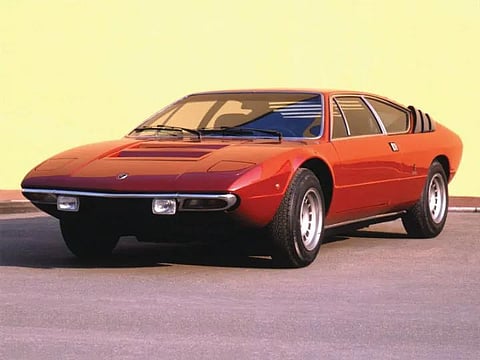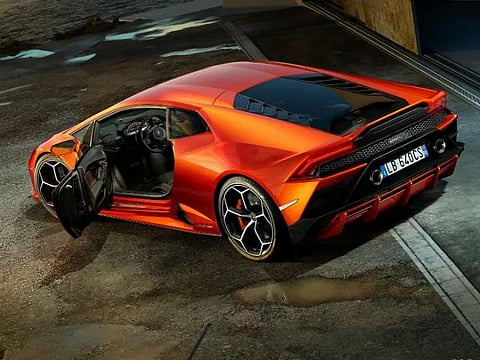Why would a company famous for its unwavering tradition of manufacturing wallpaper-worthy V12-powered supercars need any other car in its portfolio? Simply put - money, or the lack thereof. What people forget is that flagships like the Miura, Countach, Diablo, Murciélago or the Aventador have a limited clientele and drain a company’s resources unless supplemented by cars which seem to be mass produced in comparison. Here's a brief glimpse of how the evolution of such supplementary cars has culminated in the latest 'baby Lambo', the Huracan Evo.
Baby Lambo: The Journey That Led To The Lamborghini Huracan Evo
Wallpaper-worthy V12-powered monsters need some help from their smaller siblings
The first non-V12 Lambo
Urraco (1973-1979)

The Urraco was supposed to be the perfect sporty tourer for people aspiring to own a Lamborghini, but unwilling to live with the quirks of owning a supercar like the Miura. In typical Lamborghini style, introduced by the Miura, the Urraco had a transverse mid-engined setup. But it had to have a ‘practical’ 2+2 seating setup, which meant the Urraco was fitted with a compact V8 engine (which ranged from 2.0-litre to 3.0-litre). The Urraco had a price tag that gave contemporaries like the Ferrari Dino and Maserati Merak a run for their money while offering interior space and practicality that the others could not.
The Urraco P300 was powered by a 3.0-litre, naturally-aspirated V8 developing 250PS of maximum power and 265Nm of peak torque and could do the 0-100kmph run in 5.6 seconds! While 791 units were made, a combination of factors including manufacturing problems, issues with compliance for the US market, a general downturn in the world economy and the company’s focus on developing its next big supercar, the Countach, hampered its development and eventual success as a model.
Supercars are not supposed to be THAT convenient
Silhouette (1976-1979)

The Silhouette began life as a design study and was based on the chassis and internals of the Urraco, but with most of the practical features removed for a more stylish, sportier look. It was the first Lamborghini to feature a Targa top roof and an updated version of the largest engine used on the Urraco - the 3.0-litre, all-aluminium, naturally aspirated V8. This engine developed 269PS of maximum power and 275Nm of peak torque and could propel the car from 0-100kmph in 6.5 seconds.
Apart from the uncharacteristic name, the Silhouette also suffered due to the changing of hands of the company from its founder Ferruccio Lamborghini to Georges-Henri Rossetti and René Leimer in 1974. Only 54 units of the supercar were ever made before the company went bankrupt and changed hands again in 1980.
Resurgence
Jalpa (1981-1988)

Developed under the leadership of Lamborghini’s new owners Jean-Claude Mimran and Patrick Mimran, the Jalpa, along with LM002, brought the company back to life. It brought back the tradition of Lamborghini cars being named after fighting bulls, used an improved version of the now six-year-old all-aluminium V8 and was a fine daily alternative to the Countach.
The 3.5-litre V8 developed 259PS of maximum power and 305Nm of peak torque and was faster in the 0-100kmph run as compared to the Silhouette by 0.5 seconds. The Targa roof was carried over from the Silhouette, though the design was changed to give it a unique look. 410 units of the Jalpa were sold worldwide, a welcome sign for a company trying to make a comeback.
Volkswagen takeover and the realisation of a dream
Gallardo (2003-2013)

Because it changed hands multiple times (Mimran Brothers > Chrysler > Mycom Setdco+V'Power Corporation > Volkswagen Group), Lamborghini’s next update to the ‘small supercar’ lineup had to wait more than a decade. The Gallardo was the answer and borrowed its philosophy from the 1995 Lamborghini Calà concept made by Italdesign Giugiaro, which in turn was inspired by the 1987 Lamborghini P140 prototypes made in anticipation of finding a replacement for the Jalpa. The Calà concept had a mid-mounted 4.0-litre V10 engine, the first-ever such engine developed by Lamborghini mounted mid-ship and paired to a 6-speed manual transmission. The 1990 Gulf Oil crisis put its development on hold, and plans began in earnest for a replacement only after Volkswagen took over the company in 1998.
The Gallardo marked the inception of Lamborghini's new tradition of styling its cars much like stealth fighter jets, rather than just following the wedge shape the Countach made famous decades earlier. Straight cut lines, sharp intakes behind the doors, short overhangs and the absence of Italian quirks made the Gallardo and Murcielago almost alien to classic Lamborghini fans. But the new Lamborghini was not aimed at dew-eyed oldies, it was aimed at a whole new breed of buyers. Also changed was the transverse engine setup; the Gallardo had an LP (Longitudinal Posteriore) or rear-mid-engine longitudinal setup.

The Gallardo was initially powered by a 5.0-litre V10 placed longitudinally now and paired to either a 6-speed manual transmission or a 6-speed ‘E-Gear’. The E-Gear was a fancier way of saying the supercar had an AMT! Its engine was tuned to develop up to 530PS of max power in the Superleggera, though torque was limited to 510Nm. The Gallardo was the fastest small Lamborghini ever, with 0-100kmph times as low as 3.8 seconds.
The Gallardo facelift, launched in 2008, was fitted with a larger 5.2-litre V10 motor developing up to 570PS of maximum power and 540Nm of peak torque. The result? 0-100kmph time of 3.4 seconds and a top speed of 325kmph.
After a successful run of 10 years, in which Lamborghini saw its highest ever sales of 14,002 units from a single model, the last Huracan rolled out of the Bologna factory on 25 November 2013. The car was as special as it could get. Apart from the fact that it was the last Gallardo ever, it was an LP 570-4 Spyder Performante - a topless version of a superfast car.
The small Lamborghini supercar is alive and well...
Huracan (2014-2018)

After the popularity of the Gallardo, the next small supercar from Lamborghini had big shoes to fill. This time, it would make even more money, not just for Lamborghini, but the whole Volkswagen group as well, by sharing most of its parts with the second-gen Audi R8 - which in turn tapped a lot into the VW parts bin.
The Gallardo’s V10 was carried over, now developing more power and torque, paired to a new dual-clutch transmission. A smarter AWD system and rear wheel steering made it a great handling machine. A 12.3-inch virtual cockpit instrument cluster added to the wow factor on the inside.
RWD variants of the Huracan were introduced two years after the model was first launched, powered by a detuned version of the V10 engine. Many special editions followed - the Avio edition which paid homage to the Italian Air Force and a one-off LP 580-2 Pope Francis which was auctioned for charity.

The pièce de résistance for the Huracan was the LP 640-4 Performante. It used a combination of improved engine performance (640PS/601Nm), lower weight, improved mechanical grip and, for the first time in Lambo’s small supercar history, vastly improved aerodynamic grip. The ALA (Aerodinamica Lamborghini Attiva) active aerodynamic package used flaps and vents around the car to help corner better or improve top speed without using complex and heavy hydraulic moving parts. It started a proxy war over Nurburgring lap times with Porsche, setting a time of 6:52.01 in October 2016.
….but then there’s the Urus
Huracan Evo (2019-)

The Huracan has been given a comprehensive facelift which adds aggression to the design. It also receives most of the features seen on the Performante, including the engine, suspension, drivetrain, rear-wheel steering and implementation of some of the aerodynamic lessons learnt from the performance model.
The Lamborghini Huracan Evo will continue the tradition of offering the performance, heritage and exclusivity of a Lamborghini at a lower price point. But there’s a new challenge for it to handle, the very popular Urus SUV. Will Lamborghini’s small supercar be replaced by an SUV? The next-gen flagship Lamborghini may no longer be a naturally aspirated V12-powered monster, so anything is possible!
Source: zigwheels.com